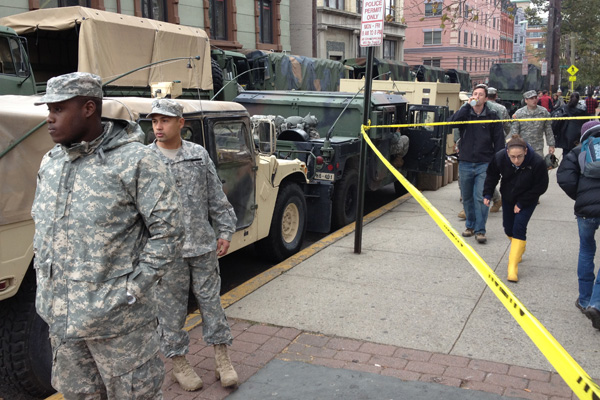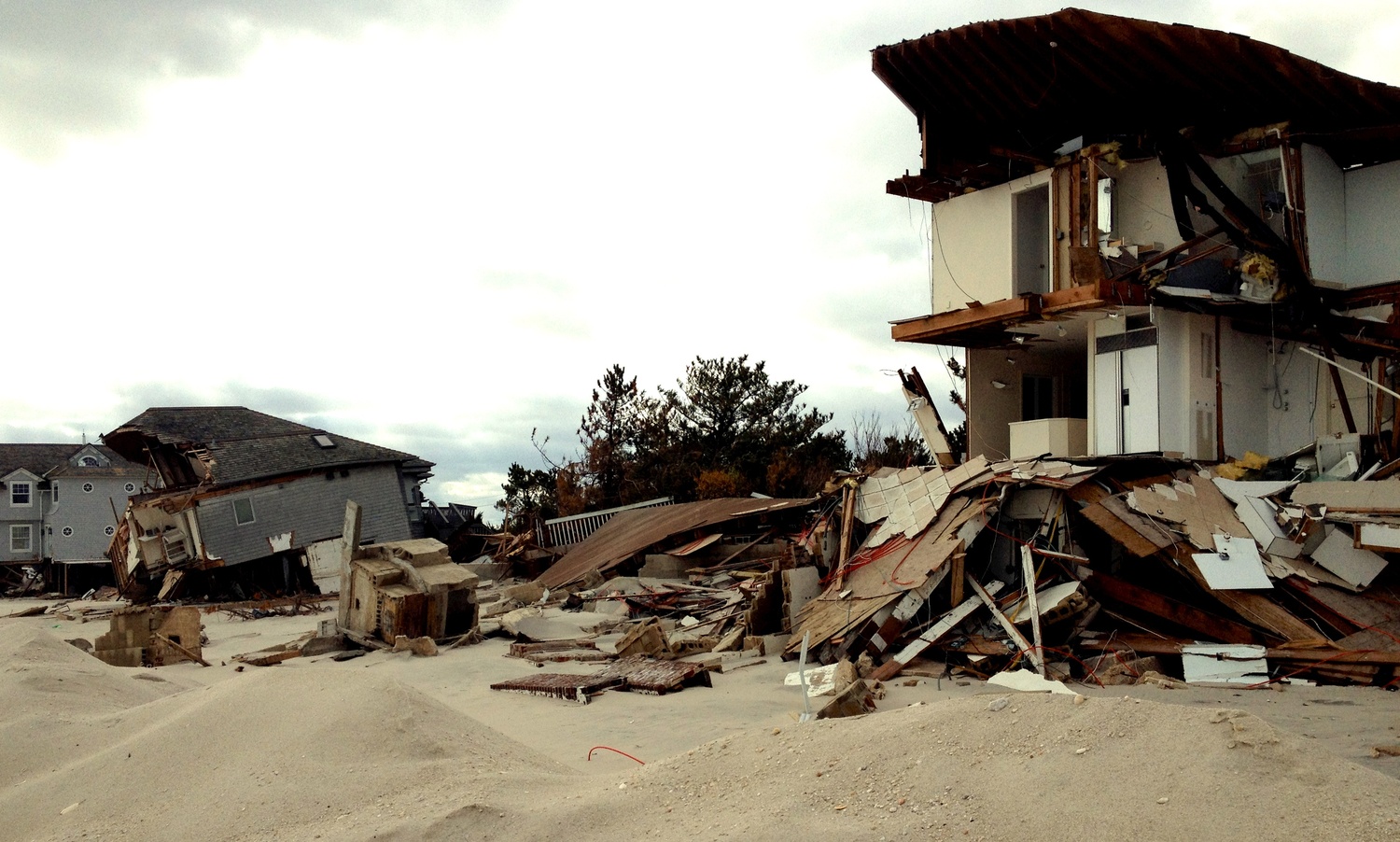NJ.com, Apr. 13, 2014

Roger Hodge, a site foreman with Environtech LLC installs a ventilation fan on a home located on Manufacturers Place that have tested positive for a chemical called TCE. The street was once home to Ronson Company, which manufactured cigarette lighters. The State Department of Environmental Protection discovered the gas underneath the homes and businesses in the area that seeps in through a basement, crawlspace or slab floor. (Robert Sciarrino)
By Barry Carter / Star-Ledger
This is a column about a horror show you pray will never happen to you.
You buy a house you can finally afford in a new neighborhood of 19 two-family homes in Newark’s Ironbound. Manufacturers Place, as the street is called, is not the prettiest of places, adjacent to a truck and scrap metal junkyard and railroad tracks.
The street is too narrow for kids to go out and play soccer or tag. There are no stoops, either, for families to sit out front. It’s just a street with homes, but, hey, at least you have your own home and the pride that goes with being able to say that.
Then out of the blue in January state officials tell you they’re sorry but it turns out that for at least 12 years you have lived on top of contaminated groundwater filled with toxic vapors that can be lethal.
They say plumes of vapors sliding around underneath residents’ homes are something called Trichloroethylene (TCE), a volatile organic compound left in the groundwater by Ronson Metals Corp., a company that once occupied the land where it made cigarette lighters and other products from the 1950s to 1989. The seepage of TCE through groundwater is a phenomenon called vapor intrusion.
If exposed to the vapors for long periods of time, residents were told, there could be nerve, kidney and liver damage, and that’s just to name a few. The compound, they were told, can also cause cancer.
Now the homeowners are angry and scared and they feel trapped. How can they get out of this dilemma? Who would buy their homes now? Who can help?
“Who is responsible?” said Ana Stival, who moved there in 2003 and says she paid $380,000 for her home. “Why did they (city/state) give permission to do something over here like this?”
Right now neither the city of Newark nor the state Department of Environmental Protection is taking the blame. Both instead are pointing the finger at each other.
In a classic case of whodunit, DEP spokesman Larry Ragonese said, deed restrictions were placed on the land that clearly spell out what can be on there — parking and nonresidential uses only. In other words, there shouldn’t be any homes on the property, and the state has no idea how that happened.
Newark says the DEP isn’t telling the whole story. Yes, there are deed restrictions, but Business Administrator Julien X. Neals said they pertain only to parcels of land across the street from the homes.
He said the city’s planning board approved the project in 2000 after it had the developer, Jose Rei of Rei Corp. get a letter from the DEP that said there were no environmental problems with the land where he wanted to build.
“They (DEP) cleared that area and the project proceeded,” Neals said. “Once we got the unrestricted use for those parcels, they were entitled to go forward.”
Scrambling on Friday afternoon, Newark did produce a letter from the DEP to Ronson, dated July 24, 2000, that appears to say there are no radiological issues to be addressed in the land cleanup.
Ragonese said the state’s position has not changed. The letter the city is talking about has nothing to do with building homes nor can it trump strict conditions in the deed.
“The deed restrictions were never removed or revoked,” he said. “No one ever came to us to seek a change in that. There’s nothing else to say.”
Meanwhile the developer can’t be found. When I called a cellphone number, a man who answered to “Jose Rei” hung up on me. His phone went straight to voicemail when I called back. The last address listed for Rei was South Terrace in Short Hills. No one answered the door. He also lived on Pennsylvania Avenue in Union, but a resident who opened the door said he hasn’t lived there in seven years. It’s almost as hard to figure out if anyone is still associated with Ronson, too. More on that later.
This all started when the DEP did a mandatory site review sometime after RCLC Inc., formerly known as Ronson Corp., closed in 1989. Ragonese said the state agency found TCE, a man-made solvent used to clean grease from metal, was present in the soil and groundwater.
As part of the remediation plan, Ragonese said, Ronson, which at some point changed names to become Prometcor, cleaned up the soil, capping it with compacted clay, textile cloth, crushed stone and asphalt.
The company, says the DEP, was also told to place a deed restriction on the property, which is as plain as day on page 4 of the deed dated Jan. 30. 2002.
Now, many years later, the DEP has found that apparently Ronson did almost everything it was supposed to do, except it walked away from the groundwater cleanup.
But the DEP can supply no evidence of whether it kept track of what the company did to make sure it completed the necessary work.
Ragonese couldn’t explain why there was no DEP follow-up or any evidence of such.
But Stephen Kehayes, Newark’s director of brownfield redevelopment with Brick City Development, has a good idea of what may have happened because he was a DEP supervisor for 27 years in its brownfield division.
Kehayes said owners of contaminated sites back then were not reporting to the state about the status of their property, such as whether the land was still capped or if deed restrictions were still in place. It didn’t help, he said, that the DEP had no good way, as it does now, to make sure owners are in compliance.
The DEP finally checked on the property in 2012 when it was in the midst of doing a systematic review of contaminated sites in the state to see if more cleanup needed to be done on outstanding cases.
Once they made it to Manufacturers Place, Ragonese said, the DEP expected see vacant land or empty Ronson buildings near collapse. After all, the deed restriction said parking lots and nonresidential only.
Instead, they were stunned to find an entire neighborhood of homes with driveways, fences, backyards and trees.
“That’s what we don’t understand,” Ragonese said. “The deed restriction is very clear. There’s housing in a place where there’s not supposed to be housing.”
Homeowners in this small working-class community see it in even starker terms.
They had no way of knowing that vapors could seep into their homes.
“Someone messed up big time here,” said Stival’s neighbor, Roberta Woisky. “I’m so upset by this situation.”
The DEP delivered the gut-check news in January to residents who attended a community meeting at the Ironbound Community Center. They were told the DEP started testing last year and high levels of TCE were found in six homes and a few businesses.
This meeting was to reach more residents who didn’t respond to DEP letters about air contamination until the Ironbound Community Corp., a social service organization, went door to door translating to an immigrant population leery of government.
“They may think it’s terrible and don’t want to know,” said Cynthia Mellon, an ICC environmental justice organizer.
In homes where TCE has been found, the state is installing an elaborate ventilation system to suck the vapors from underneath the garage floor through 40 feet of 4-inch PVC pipe that extends above the roof. Since the meeting, the number of affected homes has increased to 13 and could get higher because the state is now testing on Vincent Street, the next block over.
So many questions swirl through residents’ heads and so many worries.
Years ago, longtime residents such as 77-year-old Rosemarie Reed didn’t think anything about industry. Companies were part of the neighborhood where husbands and wives raised their children. Ronson was there, a junkyard was across the street, and another place that did something with bleach.
“It’s over the years that we’re starting to find out about chemicals,” she said. “I’m just hoping it doesn’t harm you in any way.”
The City Council chimed in recently with a resolution calling on the DEP to clean up the groundwater as it installs the air systems. That option is not on the table, but it’s something the DEP says it will look at down the road.
Residents with the air-venting system don’t like it, wondering if the ailments they have were caused by the chemical creeping into their homes.
Woisky said she takes thyroid medication and doesn’t know why when she was fit as a fiddle five years ago.
“I’m always wondering what made me feel like this,” she said. “Why am I feeling sick all of the time?”
Stival has the device, too, but she said levels of iron in her blood are elevated and her husband is always congested. Four kittens they kept in the garage, where TCE levels were high, died last year.
They’ll never know if it’s the TCE or something else in a neighborhood where life was already challenged.
Life is hard enough at Manufacturers Place already.
Planes fly above the homes constantly. Tractor-trailers puffing diesel smoke crawl down the street all day and night into a trucking yard at the end of the block. Freight trains pass twice a day at the edge of back yards, their horns blasting, the clicketyclack of train wheels rolling across the tracks just as noisy. The view when Alessandro Agostino does dishes looking out the kitchen window is a dingy iron wall topped with barbed wire that barely hides crunched up cars at a scrap metal yard.
And we can’t forget about the gizmo sending the vapors into the air that the state just installed.
He can hear it now, what a prospective buyer might say to him if he tries to sell.
“ ‘What’s this thing on the side of your house?’ ” Agostino joked.
“ ‘Oh, it’s just pushing dirty air,’ ” he’ll probably say.
It’s not much of an option, but what can you do but live with it and hope for the best?
Part of the difficulty for everyone is that the case goes so far back now. It took a long time just to find someone who was with Ronson in 1989.
I eventually did run down a nice old guy named Louis V. Aronson, the former Ronson president, now living in Whitehouse Station. He said everything was cleaned up back then as far as he knows.
“I believe so," he said.




